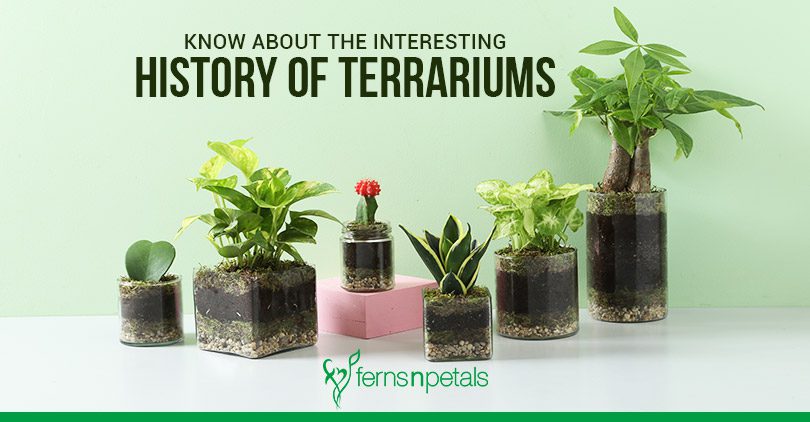The normal habitat of plants used to be forests but then human beings started to build their homes clearing the forests. They started to build homes with gardens in front or back. Then humans became more civilized and thus the gardens became smaller and pots came into much use to accommodate the plants. Currently, due to the lack of space and also due to the hazardous climate outside, people have to bring greenery inside their home and office. The indoor air remains clean and clear and people fall less sick.
Terrariums are one of the much popular and trendy home décor items in urban homes where people have limited space. Terrariums add the much-needed beauty to space and also wipes way toxins from the atmosphere. For the uninitiated, a terrarium is generally a sealable glass container containing soil and plants. One can open it to maintain the plants. Terrarium plants come in both closed and open glass containers.
Do you know that the history of these terrariums is more than a century old? You can learn many such interesting stories about the history of terrariums in the points mentioned below.
History of Terrariums:
- Nathaniel Bagshaw Ward in the year 1842 developed of the first terrarium.
- Ward was a botanist. He had huge interests in observing the behaviour of an insect chrysalis transform into an insect so he placed it, along with some mould in a wide-mouthed glass bottle.
- Ward used to keep a close eye on this bottle daily. He noted how the moisture used to rise towards the top of this bottle during the day and then circulate down the mould and soil in the evening. This happened due to the sun or heat.
- Mr. Nathaniel Bagshaw Ward was taken by surprise when a seedling fern and a sprout of grass grew inside the bottle. He has been trying to grow the same thing in his garden but was unsuccessful.
- It was then he realised that the local factors of pollution were playing with the growth of the same fern but inside this little bottle they were away from toxins and that’s why they grew there.
- He then placed this glass container outside the window to continue his studies. He did many experiments because he wanted to know about the health of the plants kept inside glass containers where there will be no outside intervention or watering.
- These small glass containers were known as Wardian Cases for a very long time. In fact, this term is still in use.
- The general perception about plants was that plants require constant exposure to air, water, or light and cannot live inside enclosed places. But Ward broke this concept and thus helped many people who were on a sea voyage where freshwater supplies were limited.
- George Loddiges – the owner of the Loddiges and Sons Nursery in Hackney supported this experiment of Ward because he understood that this sealed glass container presentation of plants had a commercial future.
- Ward then employed special carpenters to build his Wardian Cases. And by the year 1833, they sent two Wardian cases of plants to Australia. The ship then returned after a year with a load of flourishing Australian specimens. As per Ward, “These plants were placed upon deck and were not once watered during the whole voyage, yet on their arrival at the docks they were in the most healthy and vigorous condition.”
- After this successful trip, the plants from Australia were sent to London using the same method. That voyage was also successful.
- This successful ecological transports encouraged a general interest among the population. It was noticed that the middle-class homes rushed to add a Wardian case to their drawing-room as a decorative object that appealed Eden in the face of England’s dawning industrial revolution.
- During the Victorian Era and principally in England, the terrariums or “Wardian Cases” became very famous. But again over the course of time, this practice saw a decline. In today’s world, it seems like they made a comeback.
- The Wardian Cases were quite renowned during the Victorian England. Those cases used to have a series of sheets of glasses framed together with metal.
How Terrariums Work?
It is fascinating to learn how plants live happily inside a closed glass box – right? Well, the terrariums use the process of condensation and evaporation to maintain humidity. The transparent glass walls allow both the heat and light to enter the terrarium. This creates a small scale water cycle inside the glass walls. Moisture from both the soil and plants evaporates in the raised temperatures inside the terrarium. The water vapour then condenses on the walls of the glass container and eventually falls back on the plants and soil. Therefore, there is an incessant supply of water inside this sealed glass walls. This process prevents the plants from drying up and keeps them healthy.
Apart from the closed terrarium plants, there are open terrariums too. It is the plant type that decides whether it would be a closed or an open terrarium. For example, tropical plants like ferns, orchids, or mosses would require a closed terrarium. The temperate plants like cactus require open terrarium.







